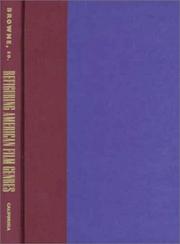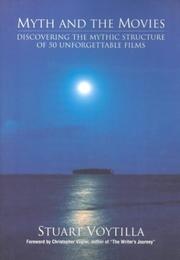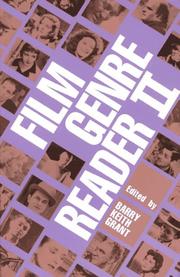| Listing 1 - 10 of 144 | << page >> |
Sort by
|
Book
ISBN: 9780292726802 0292726805 9780292735415 0292735413 Year: 2021 Publisher: Austin
Abstract | Keywords | Export | Availability | Bookmark
 Loading...
Loading...Choose an application
- Reference Manager
- EndNote
- RefWorks (Direct export to RefWorks)
A series of movies that share images, characters, settings, plots, or themes, film cycles have been an industrial strategy since the beginning of cinema. While some have viewed them as "subgenres," mini-genres, or nascent film genres, Amanda Ann Klein argues that film cycles are an entity in their own right and a subject worthy of their own study. She posits that film cycles retain the marks of their historical, economic, and generic contexts and therefore can reveal much about the state of contemporary politics, prevalent social ideologies, aesthetic trends, popular desires, and anxieties. American Film Cycles presents a series of case studies of successful film cycles, including the melodramatic gangster films of the 1920s, the 1930s Dead End Kids cycle, the 1950s juvenile delinquent teenpic cycle, and the 1990s ghetto action cycle. Klein situates these films in several historical trajectories—the Progressive movement of the 1910s and 1920s, the beginnings of America's involvement in World War II, the "birth" of the teenager in the 1950s, and the drug and gangbanger crises of the early 1990s. She shows how filmmakers, audiences, film reviewers, advertisements, and cultural discourses interact with and have an impact on the film texts. Her findings illustrate the utility of the film cycle in broadening our understanding of established film genres, articulating and building upon beliefs about contemporary social problems, shaping and disseminating deviant subcultures, and exploiting and reflecting upon racial and political upheaval.
Film genres --- Motion pictures --- Social aspects --- Genre films --- Genres, Film --- Motion picture genres --- Plots, themes, etc.

ISBN: 052091855X 0585272921 9780520918559 9780585272924 9780520207301 0520207300 9780520207318 0520207319 0520207300 0520207319 Year: 1998 Publisher: Berkeley University of California Press
Abstract | Keywords | Export | Availability | Bookmark
 Loading...
Loading...Choose an application
- Reference Manager
- EndNote
- RefWorks (Direct export to RefWorks)
This collection of essays by leading American film scholars charts a whole new territory in genre film criticism. Rather than assuming that genres are self-evident categories, the contributors offer innovative ways to think about types of films, and patterns within films, in a historical context. Challenging familiar attitudes, the essays offer new conceptual frameworks and a fresh look at how popular culture functions in American society. The range of essays is exceptional, from David J. Russell's insights into the horror genre to Carol J. Clover's provocative take on "trial films" to Leo Braudy's argument for the subject of nature as a genre. Also included are essays on melodrama, race, film noir, and the industrial context of genre production. The contributors confront the poststructuralist critique of genre head-on; together they are certain to shape future debates concerning the viability and vitality of genre in studying American cinema.
Film genres --- Film --- Music, Dance, Drama & Film --- Genre films --- Genres, Film --- Motion picture genres --- Motion pictures --- Plots, themes, etc.
Book

ISBN: 1474412963 1474412955 9781474412957 9781474412964 9781474412940 1474412947 1474455115 Year: 2022 Publisher: Edinburgh
Abstract | Keywords | Export | Availability | Bookmark
 Loading...
Loading...Choose an application
- Reference Manager
- EndNote
- RefWorks (Direct export to RefWorks)
With case studies of the Cold War comedy, the 'rogue cop' film, the brainwashing thriller and the urban romances, Cold War Film Genres explores these myriad productions, redefining American cinematic history with a more inclusive view of the types of films that post-war audiences actually enjoyed, and that the studios provided for them.
Film genres. --- Genre films --- Genres, Film --- Motion picture genres --- Motion pictures --- Plots, themes, etc. --- Film genres --- History
Book
ISBN: 9781405156509 9781405156516 Year: 2008 Publisher: Malden, Mass. Blackwell
Abstract | Keywords | Export | Availability | Bookmark
 Loading...
Loading...Choose an application
- Reference Manager
- EndNote
- RefWorks (Direct export to RefWorks)
Written in a clear, engaging, jargon-free style, this volume offers a cutting-edge theoretical overview of the topic of genre as practiced in British, American and French film criticism.
Film --- film --- filmtheorie --- filmgenres --- 791.41 --- Film genres. --- Film genres --- Genre films --- Genres, Film --- Motion picture genres --- Motion pictures --- Plots, themes, etc.

ISBN: 9780941188661 0941188663 Year: 1999 Publisher: Studio City - Westport : Michael Wiese Productions,
Abstract | Keywords | Export | Availability | Bookmark
 Loading...
Loading...Choose an application
- Reference Manager
- EndNote
- RefWorks (Direct export to RefWorks)
798.3 --- film --- filmanalyse --- mythen --- scenario --- film, esthetiek en kritiek --- Film genres --- Motion pictures --- Genre films --- Genres, Film --- Motion picture genres --- History --- History and criticism --- Plots, themes, etc.

ISBN: 0585276749 9780585276748 0791445135 0791445143 9780791445136 9780791445143 0791492958 Year: 2000 Publisher: Albany, N.Y. State University of New York Press
Abstract | Keywords | Export | Availability | Bookmark
 Loading...
Loading...Choose an application
- Reference Manager
- EndNote
- RefWorks (Direct export to RefWorks)
Film genres --- Music, Dance, Drama & Film --- Film --- Genre films --- Genres, Film --- Motion picture genres --- Motion pictures --- Plots, themes, etc. --- Filmgenres --- Verenigde Staten.

ISBN: 029272778X Year: 1997 Publisher: Austin University of Texas press
Abstract | Keywords | Export | Availability | Bookmark
 Loading...
Loading...Choose an application
- Reference Manager
- EndNote
- RefWorks (Direct export to RefWorks)
Motion picture plays --- Scénarios de cinéma --- History and criticism --- Histoire et critique --- -Film plays --- Film genres --- 791.43 --- 791.43 Filmkunst. Films. Cinema --- Filmkunst. Films. Cinema --- Genre films --- Genres, Film --- Motion picture genres --- Motion pictures --- Plots, themes, etc.
Book
ISBN: 3030304523 3030304531 Year: 2019 Publisher: Cham : Springer International Publishing : Imprint: Palgrave Pivot,
Abstract | Keywords | Export | Availability | Bookmark
 Loading...
Loading...Choose an application
- Reference Manager
- EndNote
- RefWorks (Direct export to RefWorks)
“Eamonn Jordan’s comprehensive exploration of how certain forms of justice, and its institutional enactment, figure in the many works of Martin McDonagh offers an invaluable critical guide to an oeuvre that engages deeply, and often enigmatically, with legal and philosophical questions.” - R. Barton Palmer, Professor of Literature at Clemson University and author or editor of notable books including After Hitchcock: Influence, Imitation, and Intertextuality (2006). This book interrogates the various manifestations of rival systems of justice in the plays and films of Martin McDonagh, in analysis informed by the critical writings of Michael J. Sandel, Steven Pinker, Julia Kristeva, and in particular Amartya Sen on violence, justice, equality and the law. In McDonagh’s works, failures to investigate adequately criminal actions are matched by multiple forced confessions and umpteen miscarriages of justice. The author explores McDonagh’s creative worlds as ones where distinctions between victim and perpetrator and guilt and innocence are precarious, where the burden of truth seldom reaches the threshold of beyond reasonable doubt and where the punishments and rewards of justice are applied randomly. This project considers the abject nature of justice in McDonagh’s writing, with the vast implications of justice being fragile, suspect, piecemeal, deviant, haphazard and random. Tentative forms of justice are tempered and then threatened by provocative, anarchic and abject humour. As the author argues, McDonagh’s writing cleverly circulates rival, incompatible and comparative systems of justice in order to substantiate the necessities and virtues of justice.
Justice in literature. --- Motion pictures—Production and direction. --- British literature. --- Film genres. --- Directing. --- British and Irish Literature. --- Genre. --- Genre films --- Genres, Film --- Motion picture genres --- Motion pictures --- Plots, themes, etc.
Book
ISBN: 1137546719 1137546700 Year: 2020 Publisher: London : Palgrave Macmillan UK : Imprint: Palgrave Macmillan,
Abstract | Keywords | Export | Availability | Bookmark
 Loading...
Loading...Choose an application
- Reference Manager
- EndNote
- RefWorks (Direct export to RefWorks)
This book examines the Western genre in the period since Westerns ceased to be a regular feature of Hollywood filmmaking. For most of the 20th Century, the Western was a major American genre. The production of Westerns decreased in the 1960s and 1970s; by the 1980s, it was apparent that the genre occupied a less prominent position in popular culture. After an extended period as one of the most prolific Hollywood genres, the Western entered its “afterlife”. What does it now mean for a Hollywood movie to be a Western, and how does this compare to the ways in which the genre has been understood at other points in its history? This book considers the conditions in which the Western has found itself since the 1980s, the latter-day associations that the genre has acquired and the strategies that more recent Westerns have developed in response to their changed context. Pete Falconer is a lecturer in Film at the University of Bristol, UK. He has published work on the forms and genres of popular cinema (particularly Westerns, but also horror movies and on other aspects of popular culture, including country music).
Western films --- History and criticism. --- Motion pictures—History. --- Film genres. --- United States—Study and teaching. --- Film History. --- Genre. --- American Culture. --- Genre films --- Genres, Film --- Motion picture genres --- Motion pictures --- Plots, themes, etc.
Book
ISBN: 3030436683 3030436675 9783030436674 Year: 2020 Publisher: Cham : Springer International Publishing : Imprint: Palgrave Macmillan,
Abstract | Keywords | Export | Availability | Bookmark
 Loading...
Loading...Choose an application
- Reference Manager
- EndNote
- RefWorks (Direct export to RefWorks)
Neo-Noir as Post-Classical Hollywood Cinema suggests the terms “noir” and “neo-noir” have been rendered almost meaningless by overuse. The book seeks to re-establish a purpose for neo-noir films and re-consider the organization of 60 years of neo-noir films. Using the notion of post-classical, the book establishes how neo-noir breaks into many movements, some based on time and others based on thematic similarities. The combined movements then form a mosaic of neo-noir. The time-based movements examine Transitional Noir (1960s-early 1970s), Hollywood Renaissance Noir in the 1970s, Eighties Noir, Nineties Noir, and Digital Noir of the 2000s. The thematic movements explore Nostalgia Noir, Hybrid Noir, and Remake and Homage Noir. Academics as well as film buffs will find this book appealing as it deconstructs popular films and places them within new contexts.
Film noir --- History and criticism. --- Film genres. --- Motion pictures—United States. --- Genre. --- American Cinema and TV. --- Genre films --- Genres, Film --- Motion picture genres --- Motion pictures --- Plots, themes, etc. --- Film noir. --- United States.
| Listing 1 - 10 of 144 | << page >> |
Sort by
|

 Search
Search Feedback
Feedback About UniCat
About UniCat  Help
Help News
News